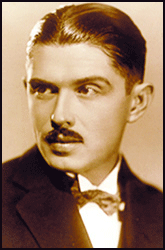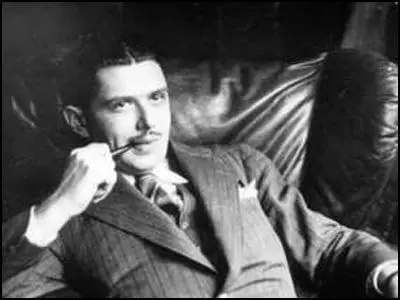Dmitri Bystrolyotov

Dmitri Bystrolyotov, the illegitimate son of Klavdiya Bystrolyotov, a clergyman’s daughter, was born in Aibory, in the Ukraine, on 4th January, 1901. He later claimed his father was Count Alexander Nikolaevich Tolstoy, the governor of Vitebsk.
Initially he was opposed to the Russian Revolution and during the Russian Civil War he fought for the White Army. However, he changed sides and joined the Combating Counter-Revolution and Sabotage (Cheka). He was sent to work undercover in Prague, Czechslovakia.
Over the next few years he developed a reputation as one of Soviet's greatest agents. John Costello and Oleg Tsarev, the authors of Deadly Illusions (1993) have pointed out: "Another colourful character who could have stepped straight out of a Hollywood spy film, Bystrolyotov was a handsome lady-killer who spoke several European languages and combined a dashing manner with great personal courage. He was adept at assuming the character of the alias he adopted for his undercover work, passing himself off as Hungarian Count Hans Gallieni in England and an English milord on the Continent. Along with Theodore Maly, he had been a member of the Soviet intelligence service's elite flying squad of agent runners who slipped back and forth across European frontiers using a clutch of false passports and identities to evade the security police of a dozen nations."
Peter Wright, a senior figure in MI5, explained in his book, Spycatcher (1987) that Bystrolyotov was one of a group of "great illegals" that included Ignaz Reiss, Walter Krivitsky, Theodore Maly, Arnold Deutsch, Richard Sorge, Leopold Trepper, Henri Pieck, Hans Brusse and Alexander Radó. "They were often not Russians at all, although they held Russian citizenship. They were Trotskyist Communists who believed in international Communism and the Comintern. They worked undercover, often at great personal risk, and traveled throughout the world in search of potential recruits. They were the best recruiters and controllers the Russian Intelligence Service ever had."
John Ehrman has pointed out: "Bystrolyotov... crisscrossed Europe, often posing as an East European aristocrat, recruiting and running French, British, German, and Italian spies. Bystrolyotov specialized in obtaining codes from West European embassies, thus giving Moscow access to diplomatic traffic. One of his assets was Ernest Oldham, the British cipher clerk who sold him London’s diplomatic codes. Bystrolyotov also often used his extraordinary good looks and charm to seduce embassy secretaries and lonely female officials who could help him gain access to codes and other information."
Bystrolyotov's first great success was the recruitment of in 1929 of Ernest Holloway Oldham, who headed the department that distributed coded diplomatic telegrams at the Foreign Office. Bystrolyotov moved to London and posed as the suave Hungarian Count Perelly. According to the authors of Deadly Illusions (1993): "Bystrolyotov... paid him £2,000 and put Oldham and his wife (who according to his report had seduced him) under Soviet control.... Because of British secrecy, the significance of the Oldham case has remained undisclosed and underestimated. The truth, as revealed by NKVD, files is that Oldham was not just a code clerk but a cypher expert who developed codes and was therefore able to provide Moscow with a great deal of information on security and secret traffic systems. The resourceful Bystrolyotov, who operated under the alias of Hans Gallieni in England, had also obtained from Oldham not only the keys to unlock a considerable volume of British cypher cables but also the names of the other paid members of the Communications Department who became targets for Soviet recruitment."
Oldham was then passed on to Henri Pieck. Oldham's codename was ARNO. His wife, Lucy Oldham, was also part of the network (codename MADAM). Oldham was paid $1,000 a month for the information he provided to the Soviet Union. It is believed that Oldham was the first Soviet spy recruited in Britain. Richard Deacon has argued: "There is evidence that Oldham did more harm to the USA and Canada than to Britain by providing the names of prospective agents in key positions in those countries. It is thought that he obtained some of these names from a mysterious female agent named Leonore. One of the Soviet contacts was a Russian oilman named Feldman who operated in Britain under the name of Voldarsky and who later started a Soviet network to spy on the USA from Canada."
According to Gary Kern, the author of A Death in Washington: Walter G. Krivitsky and the Stalin Terror (2004), Oldham in the 1930s displayed behaviour that was "a riot of drunkenness, alcohol-related sickness, professional sloppiness, wife beating, unaccountable spending and insubordination." This led to him being suspected of being a German spy. "He fell under suspicion of espionage when a codebook could not be found in a safe to which he had access. Then a batch of telegrams disappeared. Warned to observe standard procedures, he steadfastly refused and was forced to retire in September 1932, without pension."
Kern claims that Oldham was surprisingly allowed "to come into the workplace, chatted with former colleagues and crept around mysteriously with nothing to do. Keys to the super-secret storeroom were left out as a test for him and were not taken, but found to contain traces of wax after one of his visits." His controller, Walter Krivitsky, who was based in Paris, described how immense was his astonishment when he heard that in spite of his dismissal Oldham was still allowed free access to the FO and to visit his friends."
Ernest Holloway Oldham was found dead in in Kensington on 29th September, 1933. The following day The Times reported: "Kensington police are trying to trace the identity of a man aged about thirty-five, who was found dead in a gas-filled kitchen at 31 Pembroke Gardens, Kensington... the shirt bore the initials EHO." According to Richard Deacon: "After that there was absolute silence in the press, both national and local - no mention of an inquest, no obituary, no indication of the man's identity." His death certificate showed that he died from "coal gas poisoning" and a verdict of suicide "while of unsound mind" was recorded. Dmitri Bystrolyotov later admitted that the NKVD was worried that Oldham would be interrogated by MI5 and that he would reveal details of the London spy network and confessed that "our wonderful source (Oldham)... was killed by us."

In 1935 Bystrolyotov was involved in the recruitment of John Herbert King, who also worked at the Foreign Office. According to Gary Kern King was approached by Pieck: "Captain John Herbert King was a clerk without a pension or decent prospects for the future. Over beer with Pieck, he expressed himself as a disgruntled Irishman, a victim of English discrimination, under appreciated and underpaid. He had a son who deserved the best things in life and an American mistress whose tastes were not inexpensive. Pieck sympathized. He and his wife took King and his mistress on a paid vacation to Spain and made King hunger for the pleasures of high society."
King's codename was MAG. During the first year King routinely delivered a package after work to a photographic studio at 34 Buckingham Gate, not far from the Foreign Office in Whitehall, and picked it up on his way to work the next morning. The studio was rented by Pieck's business partner, Conrad Parlanti, who thought it had something to do with interior decorating. Donald Maclean (code-named WAISE) who joined the Foreign Office in October 1935, and became part of the same spy network. King was able to provide a verbatim account of a meeting that Lord Halifax had with Adolf Hitler in 1936. This was then passed on to Joseph Stalin. Dmitry Bystrolyotov recorded that "MAG works with clockwork precision."
In 1936 Nikolai Yezhov established a new section of the NKVD called the Administration of Special Tasks (AST). It contained about 300 of his own trusted men from the Central Committee of the Communist Party. Yezhov's intention was complete control of the NKVD by using men who could be expected to carry out sensitive assignments without any reservations. The new AST operatives would have no allegiance to any members of the old NKVD and would therefore have no reason not to carry out an assignment against any of one of them. The AST was used to remove all those who had knowledge of the conspiracy to destroy Stalin's rivals. One of the first to be arrested was Genrikh Yagoda, the former head of the NKVD.
Within the administration of the ADT, a clandestine unit called the Mobile Group had been created to deal with the ever increasing problem of possible NKVD defectors, as officers serving abroad were beginning to see that the arrest of people like Yagoda, their former chief, would mean that they might be next in line. The head of the Mobile Group was Mikhail Shpiegelglass. By the summer of 1937, over forty intelligence agents serving abroad were summoned back to the Soviet Union. This included Dmitry Bystrolyotov, Alexander Orlov, Theodore Maly, Yan Berzin, Ignaz Reiss, Walter Krivitsky and Vladimir Antonov-Ovseenko. Bystrolyotov was sentenced to twenty years of hard labor. Maly, Antonov-Ovseenko and Berzen were all executed. Krivitsky and Reiss refused to return and were assassinated. Only Orlov managed to escape to the United States and survive the purge.
Bystrolyotov was released after the death of Joseph Stalin in 1953. He worked at various medical research organizations in Moscow as a translator and medical consultant. Bystrolyotov published several books before his death on 3rd May, 1975.
Primary Sources
(1) John Costello and Oleg Tsarev, Deadly Illusions (1993)
Another colourful character who could have stepped straight out of a Hollywood spy film, Bystrolyotov was a handsome lady-killer who spoke several European languages and combined a dashing manner with great personal courage. He was adept at assuming the character of the alias he adopted for his undercover work, passing himself off as Hungarian Count Hans Gallieni in England and an English milord on the Continent. Along with Theodore Maly, he had been a member of the Soviet intelligence service's elite flying squad of agent runners who slipped back and forth across European frontiers using a clutch of false passports and identities to evade the security police of a dozen nations.
